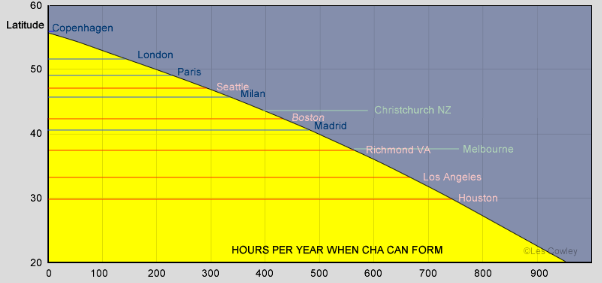Is a circumhorizon arc "rare"? It depends where you are.
Is a Circumhorizon Arc "Rare"? It Depends Where You Are
Have you ever witnessed the mesmerizing beauty of a circumhorizon arc (CHA) in the sky? This optical phenomenon, characterized by a colorful band that appears parallel to the horizon, is truly a sight to behold. However, the frequency at which you may encounter this celestial spectacle depends greatly on your location. Let's explore how the rarity of circumhorizon arcs varies across different regions.
Latitude: The Key Determinant
The key factor influencing the occurrence of a circumhorizon arc is latitude. In order for this optical phenomenon to form, the sun must be positioned higher than 58° in the sky. As you move further away from the equator, the amount of time during which the sun reaches this critical height diminishes. Consequently, regions situated closer to the poles have fewer opportunities to witness a CHA.
To illustrate this point, let's consider the Northern Hemisphere. The upper chart shows the specific dates during which the sun reaches the required altitude of 58°. At these marginal dates, the sun only grazes this threshold for a few minutes around noon. Therefore, the frequency of circumhorizon arcs is directly influenced by the number of days when the sun is sufficiently high.
The Role of Sunny Days and Cirrus Clouds
While latitude plays a significant role, it is not the sole determinant of circumhorizon arc frequency. Another crucial factor is the frequency of sunny days accompanied by cirrus clouds. Cirrus clouds are thin and wispy, often appearing high in the atmosphere. These clouds play a vital role in the formation of CHAs, as they serve as the canvas on which this colorful display is painted.
The lower chart provides insights into the total number of hours each year when the sun is higher than 58°, thereby creating favorable conditions for CHAs. Let's compare two contrasting locations: Los Angeles (LA) and London. LA enjoys nearly five times as many hours as London when the sun reaches the required altitude. When we consider England's notoriously rainy climate, it becomes evident that circumhorizon arcs are likely to be observed at least ten times more frequently in LA than in London.
Regional Disparities in Circumhorizon Arc Frequency
Now that we understand the influence of latitude and weather conditions, let's examine the disparity in CHA frequency across different regions:
1. United States of America (USA)
In the USA, especially in regions with lower latitudes, such as the southern states, it is not uncommon to witness a circumhorizon arc five or more times during the summer months. The combination of higher sun altitudes and a greater number of sunny days provides favorable conditions for CHA formation.
2. Middle Latitude Europe
In middle latitude regions of Europe, such as France, Germany, and Italy, spotting a CHA is considered a rare event. The limited number of days when the sun reaches the required altitude, coupled with unpredictable weather patterns, reduces the likelihood of encountering this optical phenomenon.
3. Northern Europe
As we venture further north in Europe, the chances of observing a circumhorizon arc diminish significantly. In fact, at any latitude north of Copenhagen, these awe-inspiring displays become impossible to witness. The combination of lower sun altitudes and a scarcity of sunny days restricts the occurrence of CHAs in this region.
A Rare Gem in the Sky
In conclusion, the rarity of a circumhorizon arc is highly dependent on your geographical location. While these vibrant bands of color are relatively common in certain parts of the United States, they become increasingly rare as you move towards middle and northern Europe. Latitude, sunny days, and the presence of cirrus clouds all contribute to the frequency at which CHAs grace our skies. So, keep your eyes peeled and hope for the perfect combination of conditions to witness this rare gem in the ever-changing canvas of the atmosphere.
How often you see the arc depends on where you are. In the USA you might see a circumhorizon arc (CHA) five or more times each summer. In middle latitude Europe you will be lucky to see a CHA once. In northern Europe they are impossible to see at any latitude north of Copenhagen. In comparison, a Parry arc is seen perhaps once a year. CHAs are common in the USA, rare in middle to north Europe.

Latitude is the key. The sun must be higher than 58° to form the arc. The further from the equator the less time that the sun is sufficiently high. The upper chart shows the dates for the Northern Hemisphere between which the the sun gets high enough. At the marginal dates the sun only grazes the required 58° for a few minutes close to noon. A second factor is the frequency of sunny days with some cirrus.

The lower chart shows the total number of hours each year that the sun is higher than 58° and therefore able to form a CHA. LA has nearly 5X as many hours as London. Factor in England's rainy climate and CHAs might be seen at least 10X more frequently in LA.
Note: this article has been automatically converted from the old site and may not appear as intended. You can find the original article here.
Reference Atmospheric Optics
If you use any of the definitions, information, or data presented on Atmospheric Optics, please copy the link or reference below to properly credit us as the reference source. Thank you!
-
<a href="https://atoptics.co.uk/blog/is-a-circumhorizon-arc-rare-it-depends-where-you-are/">Is a circumhorizon arc "rare"? It depends where you are.</a>
-
"Is a circumhorizon arc "rare"? It depends where you are.". Atmospheric Optics. Accessed on December 21, 2024. https://atoptics.co.uk/blog/is-a-circumhorizon-arc-rare-it-depends-where-you-are/.
-
"Is a circumhorizon arc "rare"? It depends where you are.". Atmospheric Optics, https://atoptics.co.uk/blog/is-a-circumhorizon-arc-rare-it-depends-where-you-are/. Accessed 21 December, 2024
-
Is a circumhorizon arc "rare"? It depends where you are.. Atmospheric Optics. Retrieved from https://atoptics.co.uk/blog/is-a-circumhorizon-arc-rare-it-depends-where-you-are/.